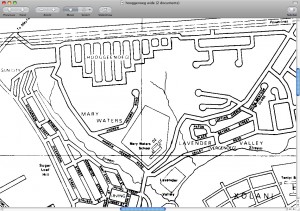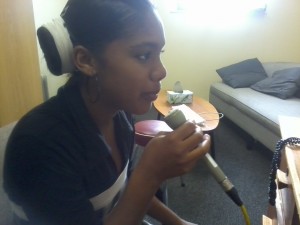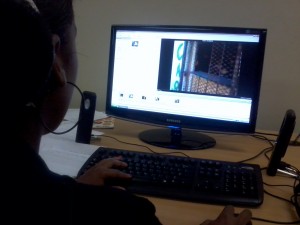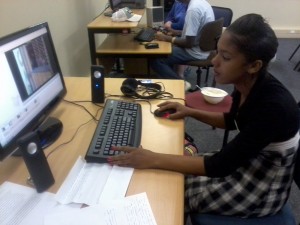 Not many people get a stroke at a young age. Besides, few people know how to support people after a stroke. This personal documentary shows how friends have helped my brother recover physically as well as emotionally by using innovative ways-by Nicole Bloch
Not many people get a stroke at a young age. Besides, few people know how to support people after a stroke. This personal documentary shows how friends have helped my brother recover physically as well as emotionally by using innovative ways-by Nicole Bloch
Archive for the ‘Thursday’ Category
Celebrate me, don’t crucify me
Teaching: a two-way process
By Tessa Trafford and Nicole Bloch.
Citizen journalism refers to the gathering, analysing and reporting of news by community members. Grocott’s Mail opened a Citizen journalist Newsroom in September 2009, and has since been training pro-active community members to become journalists. As part of this project, television journalism students from Rhodes University joined with the citizen journalist to further train them in the broadcast medium.
The citizen journalism project turned out to be a challenging journey for us as well as for Noxolo Saki, the citizen journalist. In order to be able to teach more efficiently after a short term of doing television journalism ourselves, we decided to make a manual for Noxolo which included basic information on filming, searching for a story and editing. The first big obstacle however was to get Noxolo a phone with video, as she did not have access to one. It would have been possible to get a different citizen journalist with a phone but we did not want to disappoint Noxolo and we did everything in our power to keep her in our team. A Journalism and Media Studies professor at Rhodes University then provided financial support in order to get Noxolo a phone for the project. The search for a phone and the fact that Noxolo has a two year old child caused huge time constraints. Although Noxolo started out extremely shy and did not know how to look for a good story, she soon came out of her shell and started to show some good results. In order to get some practise Noxolo was required to film a short video clip. Noxolo decided to film a clip on a church group donating boxes of fruit to the House of Joy, where many orphaned children are staying. In the clip, the owner of the house gives thanks to God.
After having had this practice Noxolo started to film for the main project. She focused on a story about litter being dumped behind a crèche in Joza, which is affecting the health of children and angers community members. The crèche is opposite Noxolo’s house making this a personal issue as well as one of great importance to the community. This makes the story hyper-local. One of the major advantages of Citizen Journalism is that community members can let their voices be heard about issues that other journalists may not be aware of.
The highlight of the citizen journalism project was the talkshow, where Noxolo’s video was played alongside that of the other citizen journalists. The video was followed by an in-studio discussion where Noxolo, who was part of the audience, was able take part in the show. To get the full story, plus more pictures and video clips, go to our timeline:
This gives you a timeline, with information and images, of the citizen journalism project.
From this project we learnt that teaching is a two way process. While we taught Noxolo about the world of broadcasting and how to create effective videos with a cell phone, we in turn learnt new skills from Noxolo as well as from the teaching process itself.
Devonia Hufkie: Citizen Journalist
When we met Devonia, we were very happy to see her! We had had some trouble with our original CJ due to communication problems. We were a bit stressed as we had very little time to do very much work. Luckily, Devonia was ready for action and jumped right into it. Working with Devonia was very easy because she was so willing to improve her journalistic skills. She tackled each project with dedication by spending alot of her time and patience on working with shooting video. Devonia did not have a cell-phone with a camera on it so one had to be arranged for her to use. This used up more valuable time and put us in a very sticky situation, regardless, Devonia never kept us waiting on a deadline or for a meeting. She was always on time and prepared with story ideas, feedback on her footage or some new route that the news stroy could take. She wanted to reprt on the youth of her residential area of Hoogeenoeg.
Her first task was to bring us a 10 second clip of absolutely anything (we did mention it would be to her advantage if there was something interesting happening in the shot). Devonia suprised us by arriving with a short clip of a young (underage) boy smoking and this included a brief interview with the boy about where he gets his money for cigarettes. We were impressed by this clip but even more impressed when she did not wait for our critisisms but rather told us. She pointed out that she had allowed shadow to fall on the subjects face and we could sense a strong irritation with herself at making this mistake. We reminded her that it’s all a part of the learning process and she has never repeated that mistake again.
The second task was to get a few different clips that could make up a longer, more well-rounded news story. Devonia decided that she would do this on underage drinking in Hoogeenoeg. However, the light of the night was not enough for her to capture anything on camera so she had to go to plan B: she completed the story of underage smokers by following them into the bushes where they hide from adults and smoke cigarettes. She captured them lighting up, smoking and putting their cigarettes out all the while asking them questions about their pre-mature habit.
Once we had looked at the footage, we placed it in order and showed Devonia how to edit it down using Windows Movie Maker. She cut her clips up and put them together in order and then she wrote down the narration that would put the news story into flow. We recorded this using a microphone plugged straight into the computer and applied it to the visuals. When it was done, Devonia was very happy with her end product and mentioned that she understood all the steps in the process and that she looks forward to creating news clips for Grocott’s online by herself. We look forward to seeing the work that she produces in the future!
Diseases that children smokers are at risk of contracting:
Comments on citizen journalism:
For more information click on the above links!
Grahamstown CJ Jennifer Linklater
- Fayo, showing CJ Jenny how to set and take a video using a cellphone
Our experience with a Grahamstown citizen journalist – Jennifer Linklater
At our first meeting with Jennifer, we discovered that apart from being a citizen journalist of Grahamstown, she is also a social worker. She nurses Tuberculosis patients and helps in raising funds for Hospice. She has an undeniable urge to create a difference and she told us that journalism is a form of activism and, through the medium of print, radio and television- one can change that change.
We discussed different story ideas revolving in and around Grahamstown and we must admit that Jennifer is not only informed and knowledgeable but also very inquisitive. These qualities signify a blossoming journalism career for Jennifer. She felt strongly about issues relating to animal abuse, bad sanitation, housing problems, the water crisis and she also wanted to cover some positive and light-hearted stories like the Grahamstown flower show, the addition of pizzas to the Dulce’s menu, the opening of Scooter’s Pizza etc.
Even though she had bright story ideas, she experienced a difficulty in drawing a distinction between stories that are suitable for phone-television medium and print medium. This is understandable since she is a citizen journalist who, before this project, had only experienced print. We explained to her the criteria for selection of stories for different mediums. It was crucial for her to know that for a television story, going to be filmed on a phone, there are certain factors that one has to keep in mind such as visually appealing shots, lighting, audio clarity, interesting ambience, target audience, accessibility and reliability of information.
We also trained her on how to use her phone (BlackBerry) and in terms of filming; we enlightened her with some of the basic rules like the six second hold, five shot rule, line rule, zooming and panning rules, etc. This training will enhance the quality of her work. Having said that, we realize that she is a citizen journalist and such journalists are not expected to be the most professional especially towards objectivity of news. Their news pieces are often highly opinionated and emotion driven. While this goes against the fundamental principle of news values, without it- citizen journalism would lose its spirit.
For the ten-second piece, Jennifer was inclined towards covering the water crisis in Grahamstown. However, upon realizing the time constraints and lack of visual appeals, she decided to do a story on the addition of pizzas in Dulce’s menus. Also since it was her first time filming, she was not confident enough to cover a controversial negative piece. Hence, we encouraged her to start off with a light-hearted Dulce’s story. While filming, Jennifer was threatened by technology. This caused her to pan the phone camera a lot. However, she eventually got used to it and obeyed the six second hold rule. Her other signs of weaknesses were impatience, restlessness, nervousness and distraction by ambience. Having mentioned that, we would also like to point out Jennifer’s strong characteristics while filming which are- curiosity to learn, her energetic and extrovert personality.
After the filming, we asked Jennifer to write a blurb. At first she didn’t have confidence in her writing but with the help of our positive guidance, she felt a lot more secure. When we gave her feedback on her filming, she took that constructive criticism and progressed in a much better way for her next project which was a minute long documentary on the sanitation issues in Hlalani.
She got the story idea from her maid, Elsie. She was able to convince us that this was a newsworthy piece which needed to be documented. It is about the lack of flush toilets in townships like Hlalani. While this may sound like the same old sanitation saga, it has a different angle. Jennifer suggested that while millions are being spent on the infrastructure in the main cities for the World Cup, most townships still have sanitation problems. Like revealed before, Jennifer is a very informed person. This has helped her a lot in finding interesting angles to stories that have been told before.
For the filming of this documentary, we went to Hlalani where Elsie lives. Jennifer suggested that Elsie would be a strong character as she has been struggling with the long drops toilets for almost ten years and she would be able to give us a good insight into the story. We were impressed with Jennifer’s journalistic ability of identifying relevant sources. We were also impressed with her filming this time. We guided her in terms of story and scene structure but with regards to the actual filming, it was her technical responsibility. Even though she exhibited anxiety at first and shook her phone every now and then, she was definitely doing better than the last time.
She filmed in different angles, explored cut-aways and interviewed Elsie using one of us as translators. Most importantly,she got so involved in the story that she has scheduled to meet up with the Media officer of the Makana Municipality, Thandi Matebese,in order to discuss the sanitation problem. She also plans to contact Habitat for Humanity for help in building a stable toilet for Elsie and others suffering from the same problem.
With regards to editing of this documentary, Jennifer was excited about the narration but not so eager to learn editing on Movie Maker. We helped her draft the narration and the blurb. Then we got a recorder and taught her how to use it. She recorded her narration and was rather pleased with this process. As far as editing is concerned, she watched and tried to learn but found it hard to cope with technology. We have encouraged her to practise, in her space and time, so that she finds herself comfortable with computers and phones. One has to take into consideration that Jennifer is 55 years old and, at this age it is natural to be intimidated by technology but with our guidance and her determination to practise and learn, she will reach that comfort level.
We would like to conclude by saying that this project has not only helped Jennifer but it has also benefited us in a lot of ways. It is always good to brush up on your knowledge, therefore,it was a mutual learning experience.
The Molteno Project
Prinesha Naidoo
An innovative approach to teaching and the improving dwindling literacy levels in rural South Africa and the world. The Grahamstown, South Africa Division of the Molteno Project is facilitated by Rhodes University’s English Department, GADRA Education and the National Department of Education.





